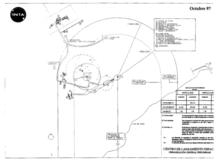El Hierro Launch Centre
El Hierro Launch Centre (in Spanish: Centro de Lanzamiento Espacial de La Isla de El Hierro) is a proposed project by Instituto Nacional de Técnica Aeroespacial (INTA) to create a spaceport on the island of El Hierro, the "Meridian Zero Island". It would be located in the south of the island, in the area of Tecorón, 5 km from La Restinga.[1] in the municipality of El Pinar, Canary Islands. It is being proposed as a center of exclusively civil use for the launch of micro- and nanosatellites with scientific or commercial objectives, such as telecommunications or Earth observation. The first rocket to be launched would be PLD Space's Miura 5 in 2022.
 | |||||||
| Location | El Pinar, El Hierro, Canary Islands, Spain | ||||||
|---|---|---|---|---|---|---|---|
| Coordinates | 27.641613°N 17.991530°W | ||||||
| Operator | INTA | ||||||
| Orbital inclination range | 72.3°-105.0°, 121.3°-152.3° | ||||||
| |||||||
The launch location would allow reaching polar orbit with a margin, without affecting the countries of West Africa. It could also be launched into an inclined equatorial orbit.[2] Other conditions that make the island a good location are the small population of the island, and the reduced maritime and air traffic, as only one airway passes over the island's airspace.
History


In 1996 INTA announced their interest[3] in creating a spaceport in El Hierro island, part of the Canary Islands archipelago. It would be the launch site for the Capricornio rocket, in development by that time, and the Minisat satellite.[4]
The proposed project had strong opposition by environmental organizations.[5] It was then proposed to a different location, to Borque de El Barbudo, near Faro de Orchilla. On 28 December 1996, there was a demonstration in which about 4,000 people convened by the Malpaso Commission participated, expressing opposition to the spaceport, and to a military radar proposed for Pico de Malpaso, as they understood the island would become a clear military objective.[6]
On 19 March 1997 Canary Islands local government created a commission to study the project's suitability, where the local government officially opposed the project.
INTA's director announced that the spaceport would have modest objectives and it would be small.[2] From there, small satellites would be launched, with solid fuel rockets and for low-altitude orbits. For launching large satellites, there is already the Guiana base in Kourou (French Guiana), of the European Space Agency (ESA). But for small missions, said the general director of INTA, Kourou is expensive.
For three years the Spanish government included 3,000 million pesetas (18,03 million Euro) in its budget,[2] but the project was opposed, so it was not implemented.
In 2015, the spaceport project was proposed again due to the plans of PLD Space to develop and launch a new rocket for small payloads, so the INTA has agreed to help them procure a launch site. The environmental organization Ossinisa shared again its concerns about the project. PLD Space replied that they are still considering other locations and argued that the purposes of the company are exclusively scientific and commercial, not military, and on the environmental aspect: that rockets leave the place "in less than ten seconds" and mention Cape Canaveral as an example, "one of the largest aquatic reserves in the United States where more than 60 rockets are launched per year."[7][8]
In 2016 United Left sent a formal query to the European Commission about their view on this emplacement, given that the island enjoys a high level of environmental protection. The Commission answered that the project at that location would be allowed, but the Government of Spain should comply with European regulations.[9]
In 2019, INTA's director José María Salom Piqueres commented in an interview that the project was being studied.[10]
See also
- List of Spaceports
- El Arenosillo Test Centre
- Instituto Nacional de Técnica Aeroespacial
References
- "Aeronautica" (PDF). Ejercitodelaire.mde.es. p. 18. Retrieved 5 September 2019.
- "La base de cohetes de Hierro no se hará si la isla no quiere, afirma el director del INTAs". El País. 10 February 1997. Retrieved 5 September 2019.
- "La Lanzadera" (PDF). 2.ulpgc.es. Retrieved 5 September 2019.
- "El Hierro vuelve a ser objetivo de una lanzadera". Eldigitaldecanarias.net. Retrieved 5 September 2019.
- "Manifestación en Hierro contra un proyecto de base espacial". El País. 30 December 1996. Retrieved 5 September 2019.
- "Diario El Hierro". Diarioelhierro.es. Retrieved 5 September 2019.
- Paz, Iago Otero. "Una empresa española estudia enviar al espacio desde Canarias cohetes reutilizables". Eldiario.es. Retrieved 5 September 2019.
- "INSTITUTO NACIONAL NEWBERIANO : Comisión de Estudios Históricos Aeroespaciales : CORREO DE NOTICIAS VIA E-MAIL" (PDF). Esga.mil.ar. Retrieved 5 September 2019.
- "Answer to Question No E-002671/16". European Parliament. Retrieved 5 September 2019.
- "Teniente general José María Salom, director general del INTA – Noticias Defensa En abierto". Defensa.com. 14 April 2019. Retrieved 5 September 2019.